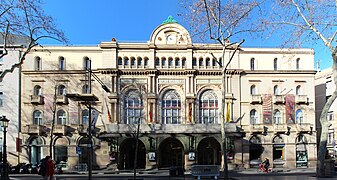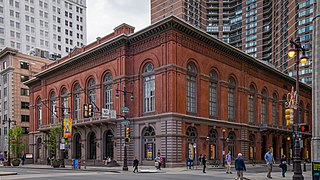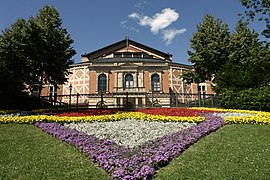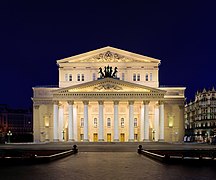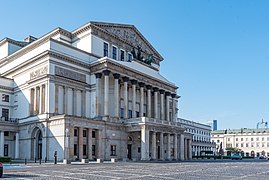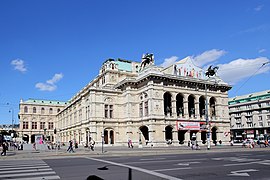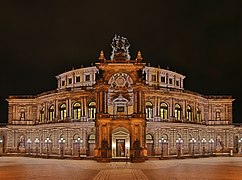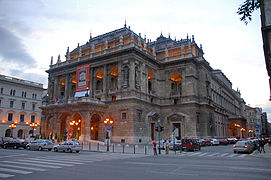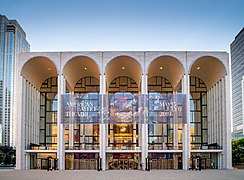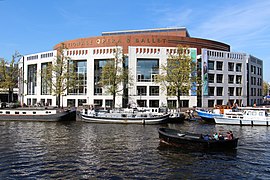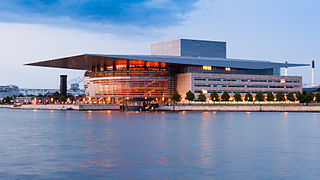Opera house


Anopera houseis atheater buildingused for performances ofopera.Like many theaters, it usually includes astage,anorchestra pit,audience seating, backstage facilities forcostumesand building sets, as well as offices for the institution's administration.
While some venues are constructed specifically for operas, other opera houses are part of largerperforming artscenters. Indeed, the termopera houseis often used as a term of prestige for any large performing arts center.
History[edit]
Greco-Roman antiquity[edit]
Based onAristoxenus's musical system,[1]and paying homage to the architects ofancient Greek theater,Vitruviusdescribed, in the 1st century BC, in his treatiseDe architectura,the ideal acoustics of theaters. He explained the use of brazen vases thatMummiushad brought to Rome after having had the theater ofCorinthdemolished, and as they were probably used in theTheater of Pompey.As wooden theaters were naturally sonorous, these vases, placed between the seats on the stands, served as resonators in the stone buildings: "By means of this arrangement, the voice, which will come from the stage as from a center, will extend in circles, will strike in the cavities of the vases, and will be made stronger and clearer, according to the relationship of consonance that it will have with one of these vases."[2]Theodeonbuilt byPericlesnear theTheater of DionysusinAthenswas, according to theSuda,intended for the rehearsal of music that was to be sung in the grand theater or, according toPlutarch,for the jury to audition musicians competing for a prize.[3]
Ancient theaters provided the ideal conditions, but it was not yet time for opera: the aim was to worship the deities, not to venerate themuses.The subject was religious, it was accompanied by singing and instrumental music. Worship was public, and the audience was made up of citizens as well as other categories of the population. Four centuries later, theChurchabandoned spectacles as practiced in Antiquity.Histrions,representative ofGreco-Roman civilization,gradually disappeared.
Middle Ages[edit]
TheMiddle Agessaw the abandonment of ancient theaters, which were transformed into gigantic stonequarries,like many other ancient buildings, both public or private. Music still had its place in worship. It continued to bring audiences together, but its content was completely renewed. TheJeu de Daniel( "Play of Daniel" ) was a sung play, characteristic of the medievalRenaissance of the 12th century.The subject, taken from thebiblicalBook of Daniel,deals withIsrael's captivity in Babylon.[4]The play was written and performed by students of the Episcopal School ofBeauvais,located in northern France.[5]In the 15th century, sung theater of a religious nature found a special place in themystery playsperformed on cathedral squares. As before, they dealt with sacred subjects, but they were not about worship per se.Secularmusical theater also existed, but had a more popular and intimate aspect (see, for example,Adam de la Halle'sJeu de Robin et Marion( "Play of Robin and Marion" ), in the 13th century).[6][7]
Modern period[edit]
At the beginning of the 17th century, in Italy, singing underwent yet another renewal, with the emergence ofBaroqueart at the height of theRenaissance.Italy continues to have many working opera houses,[8]such as theTeatro MassimoinPalermo(the biggest in the country), theTeatro di San CarloinNaplesand theTeatro alla ScalainMilan.TheTeatro San CassianoinVenicewas the world's first public opera house, inaugurated as such in 1637.[9]
In the 17th and 18th centuries, opera houses were often financed by rulers, nobles, and wealthy people who usedpatronageof the arts to endorse their political ambition and social position. There was no opera house in London whenHenry Purcellwas composing and the first opera house in Germany, theOper am Gänsemarkt,was built inHamburgin 1678, followed by theOper am BrühlinLeipzigin 1693, and theOpernhaus vorm SalztorinNaumburgin 1701. With the rise ofbourgeoisandcapitalistsocial forms in the 19th century, European culture moved away from its patronage system to a publicly supported system.
Early United States opera houses served a variety of functions in towns and cities, hosting community dances, fairs, plays, andvaudevilleshows as well as operas and other musical events. In the 2000s, most opera and theatre companies are supported by funds from a combination of government and institutionalgrants,ticket sales, and private donations.
-
Opéra-Théâtre de Metz Métropole,built by benefactorCharles Louis Auguste Fouquet, duc de Belle-Isleduring the 18th century; it is the oldest opera house working in France.
-
TheAcademy of MusicinPhiladelphiais the oldest opera house in the USA.
-
TheBayreuth FestspielhausinBayreuth(Germany) was built byRichard Wagnerand dedicated solely to the performance of his stage works.
Other uses of the term[edit]
In the 19th-century United States, many theaters were given the name "opera house", even ones where opera was seldom if ever performed. Opera was viewed as a more respectable art form thantheater;calling a local theater an "opera house" therefore served to elevate it and overcome objections from those who found the theater morally objectionable.[10][11]
Gallery[edit]
-
Teatro alla ScalainMilan,Italy
-
Berlin State OperaonUnter den Linden,Germany
-
Teatro RealinMadrid,Spain
-
Grand TheatreinWarsaw,Poland
-
Royal Theatre of La MonnaieinBrussels,Belgium
-
Mariinsky TheatreinSaint Petersburg,Russia
-
Vienna State Operain Austria
-
Palais GarnierinParis,France
-
SemperoperinDresden,Germany
-
Hungarian State Opera HouseinBudapest,Hungary
-
National TheatreinPrague,Czech Republic
-
Teatro ColóninBuenos Aires,Argentina
-
Zürich Opera HouseinZürich,Switzerland
-
Theatro MunicipalinSão Paulo,Brazil
-
New National Theatre TokyoinTokyo,Japan
-
Copenhagen Opera Housein Denmark
-
Oslo Opera Housein Norway
See also[edit]
- List of opera houses
- List of opera festivals
- List of concert halls
- List of buildings
- Small-town opera house
References[edit]
Notes
- ^Vitruvius,De architectura,Book V Chapter IV,Harmonic music according to the doctrine of Aritoxene,p. 223
- ^Vitruvius,De architectura,Book V Chapter IV,Harmonic music according to the doctrine of Aritoxene,p. 243
- ^Vitruvius,De architectura,Book V Chapter IV,Harmonic music according to the doctrine of Aritoxene,p. 286
- ^Eugene, Enrico."The Play of Daniel: European Music Series".Oklahoma: The University of Oklahoma.Retrieved2009-11-18.
- ^"The Play Of Daniel | Encyclopedia.com".
- ^Hutchinson Encyclopedia(1988), p.10
- ^Dixon, Rebecca; Sinclair, Finn E. (2008).Poetry, Knowledge and Community in Late Medieval France.Boydell & Brewer Ltd. p. 173.ISBN978-1-84384-177-7.Retrieved17 July2012.
- ^"Great Opera Houses of the World".BBC.Archived fromthe originalon Feb 15, 2009.
Opera was always popular among ordinary people as well as among the rich, so that there was a large audience available.
- ^Mancini, Franco; Povoledo, Elena; Muraro, Maria Teresa (1995).I Teatri del Veneto - Venezia.Vol. Tomo 1. Venice: Corbo e Fiore. pp. 97–149.
- ^Condee, William Faricy (2005).Coal and Culture: Opera Houses in Appalachia.Athens, Ohio: Ohio University Press. p. 6.ISBN0-8214-1588-3.
The term 'opera house' is indeed misleading, and intentionally so; it provides a veneer of social and cultural respectability and avoids the stigma of the title 'theater.'
- ^"The Name Opera House".Dramatic Mirror.March 7, 1885.
Sources
- Allison, John (ed.),Great Opera Houses of the World,supplement toOperaMagazine, London 2003
- Beauvert, Thierry,Opera Houses of the World,The Vendome Press, New York, 1995.ISBN0-86565-978-8
- Beranek, Leo.Concert Halls and Opera Houses: Music, Acoustics, and Architecture,New York: Springer, 2004.ISBN0-387-95524-0
- Hughes, Spike.Great Opera Houses; A Traveller's Guide to Their History and Traditions,London: Weidenfeld & Nicolson, 1956.
- Kaldor, Andras.Great Opera Houses (Masterpieces of Architecture)Antique Collectors Club, 2002.ISBN1-85149-363-8
- Lynn, Karyl Charna,Opera: the Guide to Western Europe's Great Houses,Santa Fe, New Mexico: John Muir Publications, 1991.ISBN0-945465-81-5
- Lynn, Karyl Charna,Italian Opera Houses and Festivals,Lanham, Maryland: The Scarecrow Press, Inc., 2005.ISBN0-8108-5359-0
- Plantamura, Carol,The Opera Lover's Guide to Europe,Citadel Press, 1996,ISBN0-8065-1842-1
- Sicca, Luigi Maria, "The management of opera houses: The Italian experience of the Enti Autonomi", Taylor & Francis,International Journal of Cultural Policy,1997,ISSN1028-6632



